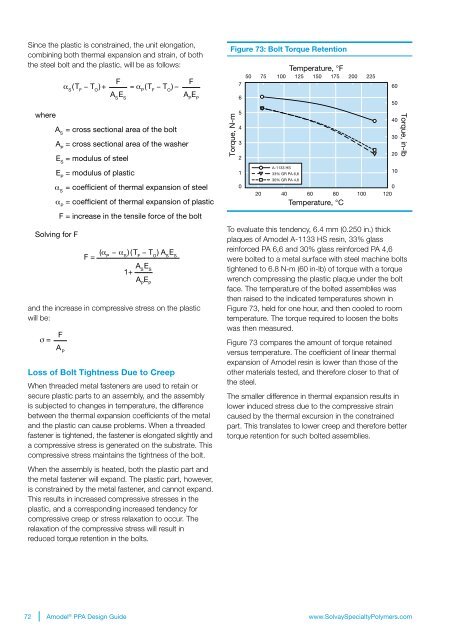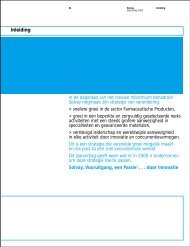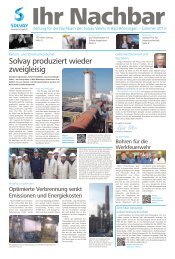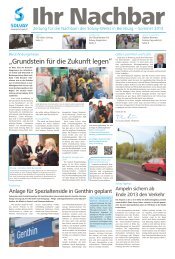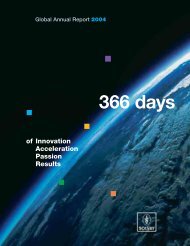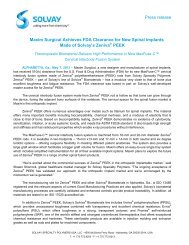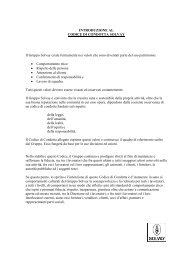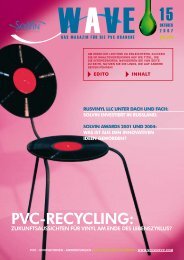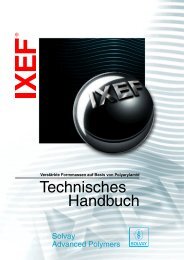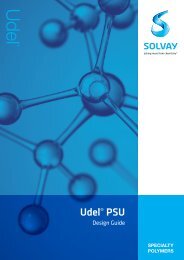Design Guide - Solvay Plastics
Design Guide - Solvay Plastics
Design Guide - Solvay Plastics
Create successful ePaper yourself
Turn your PDF publications into a flip-book with our unique Google optimized e-Paper software.
Since the plastic is constrained, the unit elongation,<br />
combining both thermal expansion and strain, of both<br />
the steel bolt and the plastic, will be as follows:<br />
where<br />
α S<br />
(T F<br />
− T O<br />
) +<br />
F<br />
A S<br />
E S<br />
= α P<br />
(T F<br />
− T O<br />
) −<br />
A S<br />
= cross sectional area of the bolt<br />
A P<br />
= cross sectional area of the washer<br />
E S<br />
= modulus of steel<br />
E P<br />
= modulus of plastic<br />
F = (α P − α S ) (T F − T O ) A S E S<br />
A S<br />
E S<br />
1+<br />
AP E P<br />
F<br />
A P<br />
E P<br />
α S<br />
= coefficient of thermal expansion of steel<br />
α P<br />
= coefficient of thermal expansion of plastic<br />
Solving for F<br />
F = increase in the tensile force of the bolt<br />
and the increase in compressive stress on the plastic<br />
will be:<br />
σ =<br />
F<br />
A P<br />
Loss of Bolt Tightness Due to Creep<br />
When threaded metal fasteners are used to retain or<br />
secure plastic parts to an assembly, and the assembly<br />
is subjected to changes in temperature, the difference<br />
between the thermal expansion coefficients of the metal<br />
and the plastic can cause problems. When a threaded<br />
fastener is tightened, the fastener is elongated slightly and<br />
a compressive stress is generated on the substrate. This<br />
compressive stress maintains the tightness of the bolt.<br />
When the assembly is heated, both the plastic part and<br />
the metal fastener will expand. The plastic part, however,<br />
is constrained by the metal fastener, and cannot expand.<br />
This results in increased compressive stresses in the<br />
plastic, and a corresponding increased tendency for<br />
compressive creep or stress relaxation to occur. The<br />
relaxation of the compressive stress will result in<br />
reduced torque retention in the bolts.<br />
Figure 73: Bolt Torque Retention<br />
Torque, N-m<br />
7<br />
6<br />
5<br />
4<br />
3<br />
2<br />
1<br />
0<br />
Temperature, °F<br />
50 75 100 125 150 175 200 225<br />
A-1133 HS<br />
33% GR PA 6,6<br />
10<br />
30% GR PA 4,6<br />
0<br />
20 40 60 80 100 120<br />
Temperature, °C<br />
To evaluate this tendency, 6.4 mm (0.250 in.) thick<br />
plaques of Amodel A-1133 HS resin, 33% glass<br />
reinforced PA 6,6 and 30% glass reinforced PA 4,6<br />
were bolted to a metal surface with steel machine bolts<br />
tightened to 6.8 N-m (60 in-lb) of torque with a torque<br />
wrench compressing the plastic plaque under the bolt<br />
face. The temperature of the bolted assemblies was<br />
then raised to the indicated temperatures shown in<br />
Figure 73, held for one hour, and then cooled to room<br />
temperature. The torque required to loosen the bolts<br />
was then measured.<br />
Figure 73 compares the amount of torque retained<br />
versus temperature. The coefficient of linear thermal<br />
expansion of Amodel resin is lower than those of the<br />
other materials tested, and therefore closer to that of<br />
the steel.<br />
The smaller difference in thermal expansion results in<br />
lower induced stress due to the compressive strain<br />
caused by the thermal excursion in the constrained<br />
part. This translates to lower creep and therefore better<br />
torque retention for such bolted assemblies.<br />
60<br />
50<br />
40<br />
30<br />
20<br />
Torque, in-lb<br />
72 Amodel ® PPA <strong>Design</strong> <strong>Guide</strong><br />
www.<strong>Solvay</strong>SpecialtyPolymers.com


